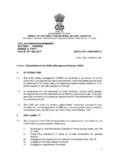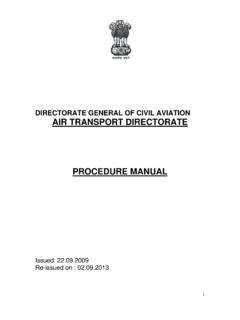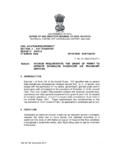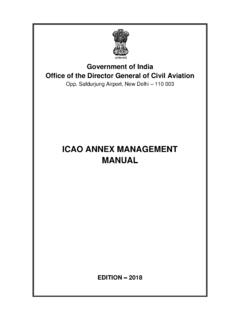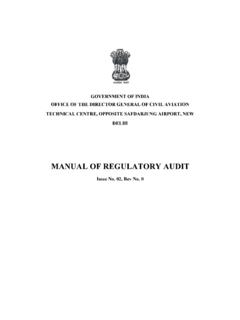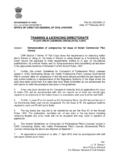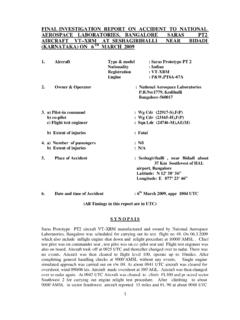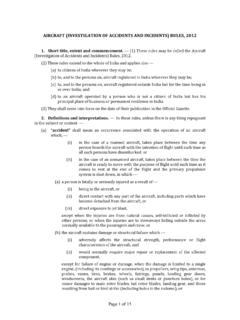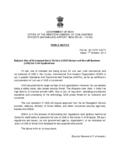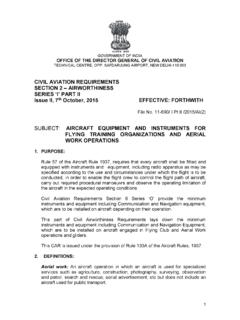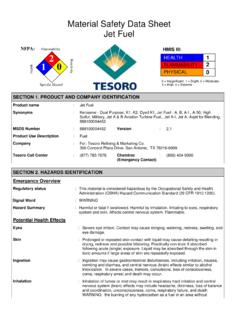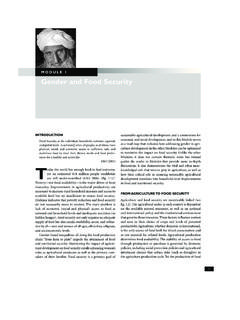Transcription of P.D.Bahukhandi Ex.DIR(QC) Indian Oil Corporation Ltd.(MD ...
1 (QC) Indian Oil Corporation Ltd.(MD ) ,30 July 2010 CONTENTS Aviation fuel - scenario in India Development of Aviation fuel Specifications Harmonization of Jet fuel Specification Aviation fuel Specification in India, Critical Characteristics and trend QC Monitoring Practices Aviation Bio-fuels developments & CSR ConclusionREFINERIES PRODUCING Capacity (MMTA)ATF Production (TMTPA) (Dom) +27 (SEZ)120008 BPCL(M) (M) (V) SALES IN INDIA & FUTURE GROWTHYearIndustryIndian oilSales% GrowthSalesMarket Share% % % fuel Specifications at a GlanceCountrySpecificationUSAASTM D 1655 04a, 6615-04aUKDEF STAN 91-91/6, 91-86/4, 91-88/2 RUSSIAGOST 10227-86(TS-1, T-1, T-1S, T-2, RT)GOST R 52050-2003 FranceDCSEA 134/AColombiaNTC 1899 CanadaCAN/CGSB & 1571 & IS 1587 ChinaGB 6537-94 JapanJFSCL Issue 16 & DSP K2206 DVenezuelaCOVENIN-1023 Major Specifications ComparisonUSAUKRUSSIAI ndia China CharacteristicsD 165591 91/6R 52050IS 1571 GB Deleted 08 5 Aromatics22%25%25%25 / 22 % 20%Silver Strip1 max DeletedDeleted 08* 1 maxLubricity / mm Refining Comp ReportReportReport Sulphur/ % 20 Smoke Point & Naphthalene's3333 3 Colour Report Report ReportParticulate mg/l mg/l ReportConductivity50 45050 60050 45050 600 50 450*Being re intoduced9/2/2009 Harmonisation Of Jet fuel Specification Modern aviation recognizes few frontiers.
2 Need for similar characteristics & requirement. Common name & standard specifications. Its availability in all parts of the world. efforts differences in minimum quality requirement among the major internationally used airlines are faced with confusing array of names, definitions & specifications for jet a partial solution airlines to quote requirement against DEF STAN AFQRJOS or IATA spec. Russia also FeaturesRef StdIS : 1571 1960 - Two Grades were covered, namely K 40 & K 50 DERD 2482/24941stRevision 1965- Requirement of WSI, Smoke Point, & Thermal Stability included- Requirement of ROE, Calorific Value, Accelerated Gum , &Mercaptan aligned with DERD2494 Latest IssueDERD 24942nd Revision 1967- Requirement of Silver Strip included &WSI replaced With WSIM(Issue 3 & 5)3rd Revision 1976-Grade K-40 deleted , being no longer of Acidity , Relative Density & Viscosity aligned with DERDDERD 2494 (Issue 7)4thRevision 1982- Aromatics contents increased from 20 to 22%- Thermal Stability by JEFTOT introduced , alignment with DERDDERD 2494 (Issue 8)5th Revision 1985-Sulphur Contents relaxed from to Freezing Point relaxed from 50 to 47 Deg C.
3 FBP modified from 288 to 300 Deg Stability deleted . Hydrogen contents &Conductivity added introducedDERD 2494 (Issue 9) Indian JET A-1 Specification DevelopmentJET A-1 Specification DevelopmentIS FeaturesRef Std6th Revision 1992 Silver Strip Corrosion relaxed 1 at refinery at Delivery end (4 Hrs). Defence Requirement of Aromatics 20 max deletedDERD 2494 (Issue 10)7th Revision 2001 Lubricity Requirement introduced Aromatics revised to 25 % .WSIM modified as MSEP with /without SDA .Lumino number deletedDef Stan (Issue 2)8thRevision 2008 Olefins contents deleted Silver Strip Corrosion Test deleted.* Sulphur Contents %by Mass for Def and Civil Aromatics Contents revised to 25 for Civil and 22for Defence (Earlier 25 ( C )/22 ( D)/20 (Russion) Conductivity Range enhanced from 50-450 to 50-600 * Being reintroducedDEF STAN 91/91 (Issue 6 ) amendment April 2008 with amendment 1 12/08/2008 is issued with requirement of check fame and report particulate contamination in sizeDEF STAN (Issue-5)DEF STAN (Issue-6)Trend in Development in Specification Jet fuel vis- -vis Auto FuelCharacteristicsJet FuelAuto FuelSulphur ContentIncreasedDecreasedAromatic ContentIncreasedDecreasedOlefin ContentDeletedLimit IntroducedBenzene contentNot Required/ SpecifiedDecreasedLubricityUnder specified conditionsLimit IntroducedFBP, DistillationIncreasedDecreasedDensity RangeNo ChangeNarrowed downFreezing PointLess StringentNot ApplicableIndian Jet fuel vis-a-vis of USA & 1655 DEF STAN 91-91/6IS 1571.)
4 20081 AppearanceC & BC & B,Colour reportParticulate 1 mg/lC & B2 Composition :a)Total Acidity, mgKOH/g, )Aromatics, % by vol., Max252525/ 22c)Olefins content, % by vol., Max------Deleted -08d)Total Sulphur, % by mass, .30/.25)e)Mercaptan Sulfur, % by mass, Max ORDoctor A-1 Specifications IOCL STAN 91/91 ISSUE 6 BIS 1571:2008 IOC1 Aromatics, % by Volume Max2525222 Sulphur, total % by mass, , mercaptan % by mass, , WSD mm Strip Corrosion TestDropped0 Max* (Refinery)1 Max (Field)0 (Ref)1 (Field)*being re-introducedQC Monitoring Practices: JIG Vs AQCAM1 fuel storage Tank internally inspected and cleaned every three storage Tank internally inspected and cleaned every Two Years. Three Years for tanks having 5 Micron filters on receipt Tank Bottom sample of storage tank subjected for Microbiological test to ascertain tank Hygiene3_Storage Tank Bottom sample subjected for Cu strip corrosion test Tanks Floating suction arms shall be checked Tanks Floating suction arms shall be checked vehicle Hose end strainers not coarser than 60 meshRefuelling vehicle Hose end strainers not coarser than 100 vehicle Hose end strainers removed & inspected MonthlyRefuelling vehicle Hose end strainers removed & inspected on vehicles supplying jet fuel be checked by Gravimetric test at least every six on vehicles supplying jet fuel are checked by Gravimetric test
5 Every Quarter(three months).QC Monitoring Practices: JIG Vs AQCAMP articulate values1 DEF STAN 91/91 (ISSUE 5)At point of ManufactureMax mg/l2 IATAAt the point of delivery< mg/l Acceptable> mg/l - Investigate> 1 mg/l Reject Fuel3 IOCAt the point of delivery mg/l Max is Operating Specification > mg/l Repeat On repetition > mg/l investigate. > mg/l Equipment withdrawn. Re-commission after investigation/ corrective FuelsBio FuelsObtainedFromNon-Renewable Mineral resourcesRenewable plant resources [Absorb CO2, sunlight to grow]ReservesWill exhaust one dayCan be grown as per requirementEmit CO2during :Use as fuel Each stage of distribution Emit CO2during :Use as fuel Auxiliary growth operations Do not absorb CO2during any stage of their life-cycle Absorb CO2 during biomass growth in next generationEnvironmental Effect0% Carbon-Neutral84 % Carbon-Neutral ImpuritiesSulphurNilSupplySupply only from regions having petroleum fields Local smaller supply chains can be establishedPricesFluctuatingStableCarbon Life-Cycle DiagramCarbon Life-Cycle DiagramFossil FuelBio FuelCO2 is emitted at each stage of distribution chainCO2 is reabsorbed as the next generation bio-stock is grownImportance of AviationImportance of AviationImpact on Global EconomyHas direct, indirect, induced & catalytic impact Equivalent to USD 3560 billionEquals % of world Gross Domestic ProductHuge growth since its beginning (5 % per annum)
6 Moves billion passengers annuallyGenerates 32 million jobs globallySocial ImpactImproves quality of life by rapid worldwide transportHas shrunk cultural barriers like no other transport sectorIndispensable for tourism & facilitates world tradeAviation to Climate ChangeAviation to Climate ChangeContribution ToGlobal Warming2% of manmade CO2emissionsMay be 3% by 2050 (increase of 2-3% per yr)Lesser pollution than other sectorsResponsible attitudeWorking towards carbon-neutral growthTechnological Measures Adopted70 % more fuel -Efficiency in past 40 yearsAircraft EnginesCutting age of efficiency (70% more in 40 yrs)A-380 / B-787 consume less than 3 ltr/100 km/PsgrCompare favorably with small family carsAircraft ShapeMore aerodynamic & lighter than ever before Air Traffic ControlHuge improvements in efficiencyAirport OperationsMuch more environ-friendlyGenerations of Bio-FuelsGenerations of Bio-FuelsFirst GenerationSecond GenerationSourcesSugar-rich Plants Bio-derived oils Land for GrowthNeed food-crop land Affect food-availabilityMay be grown in desert or salt-waterExamples of SourcesSugarcane, (Ethanol), Corn (Bio-Diesel)
7 Soybeans, algae, jatropha, halophytes, camelinaSuitability for modern jet enginesNot suitableDo not have necessary performance & Safety attributes SuitableMake high quality jet & diesel fuelsCurrent Use--Transport--Home-heating, Cooking --Power generation from stationary engines Jet & Diesel engine fuelsKey Advantages for AviationSecond Generation Sustainable Bio-FuelsKey Advantages for AviationEnvironmental Reduction in CO2emissions across their lifecycleDiversified Supply Viable alternative to fossil fuels Can substitute traditional jet fuel More diverse geographical fuel supply through non-food crop sourcesEconomic / Social Solution to fuel -price-fluctuations facing aviation Economic benefits to developing world with land unviable for food but viable for 2G bio-fuels Technical ChallengesAviation Bio-Fuels : Technical ChallengesTechnical Requirements High performance level to meet : Range of operational conditionsStringent performance targets Safety requirements Drop-in replacement for Jet A-1 Without the need to redesign Aircraft engine & fuel delivery systemFirst Generation Bio-Fuels Ethanol & BiodieselDo not meet high performance & safety requirementsSecond Generation Bio-Fuels Recent advances :Not only meet but exceed many of the current Jet A-1 specificationsJet fuel SpecificationsSecond generation Bio-Fuels Exceed Jet A-1 SpecificationsCriteriaJet A-1 Spec2ndGen Bio-FuelFlash Point (oC)38 Min Freezing Point (oC)-47 Max Combustion Heat (MJ/kg) Min Viscosity (mm2/s) Max Sulphur Content (ppm) Max Density (kg/m3)775-840 Economic ViabilityAviation Bio-Fuels : Economic Viability against Fossil FuelsFossil FuelsCosts may increase due to.
8 Increasing scarcity of fossil fuels Increasing carbon costs due to Emission Trading Scheme Sustainable Bio-Fuels Costs may reduce due to : Improvement in harvesting & processing technology Reduction in taxes on low carbon fuels New developments on advanced bio-fuels :(1) Advanced cheaper refining techniques using bacteria(2) Use of less costly feed-stocks including waste productsBio-Fuels expected to be viable by 2020 (with 10% aviation market)[Estimate may vary due to fluctuating costs of fossil fuels]From Field to WingsAviation Second Generation Bio-Fuels From Field to WingsCultivation &Harvesting Grown in fairly harsh condition with little water, Grown in non-food-crop land or even waste-land Just need to be planted, cared for, cultivated & harvested Major challenges :Increasing productivity through advanced methodsDecreasing cost-to-unit ratioProcessingTo Extract Feedstock is pressed to extract oil Solid waste (meal) is used for various purposesRefining by Hydroprocessing Removal of oxygen from feedstock Isomerisation to meet specs of Jet fuelBlending with Jet fuel drop-in blend with traditional jet fuel Bio- fuel quantities in blend to increase gradually May take place at.
9 Bio- fuel refinery / petro refinery / separate facility / airport The Next StepsAviation Second Generation Bio-Fuels The Next StepsTo Ensure Steady supply of feedstock is grown & processed into bio- fuel Refining & blending facilities are in place Cost is right to compete with petro-based fuel Share-allocation for bio- fuel in spite of competition Incentives for bio- fuel supply Sustainability of the bio- fuel suppliesPositive Incentives Assistance in identifying areas for bio- fuel growth Support in starting farming & production o algae Incentives to develop processing & refining capacity Fiscal & legal framework to facilitate economic viability Commitment Use of sustainable bio-fuels in commercial flights by 2012 Significant supply of bio- fuel in jet fuel mix by 2020 Aviation Bio-Fuels AreAviation Second Generation Bio-Fuels AreEssentialContinuing to burn fossil fuels is not sustainableViableTests prove that bio-fuels can be used in flightSustainableSecond generation bio-fuels have low impact on land or water used for food-cropsCleanerThey have around 80% reduction in CO2 lifecycle emissions compared to fossil fuelsPracticalSecond generation bio-fuels can be mixed with existing aviation fuel supplies.
10 Ass more bio- fuel is produced, we can use more across the industryComing SoonWith certification expected by 2011 bio-fuels could be used on commercial flights within 3-5 yearsSave HumanityAviation Bio-Fuels Role to Save HumanityPetro-FuelsEnd dependence on petro-fuels that are on the verge of extinctionGlobal-Warming Delay or Prevent devastating consequences of global warming Harmonization of Jet fuel specification for both civil and defence requirement will help in Availability of Common JET fuel world wide. Better Yields with less and friendly emissions Flexibility in operations/Logistics, Import/Export. Better Aviation Economics. Enhanced Flight Safety Bio- fuel for sustainability and environment protectionCONCLUSION9/2/20099/2/2009
